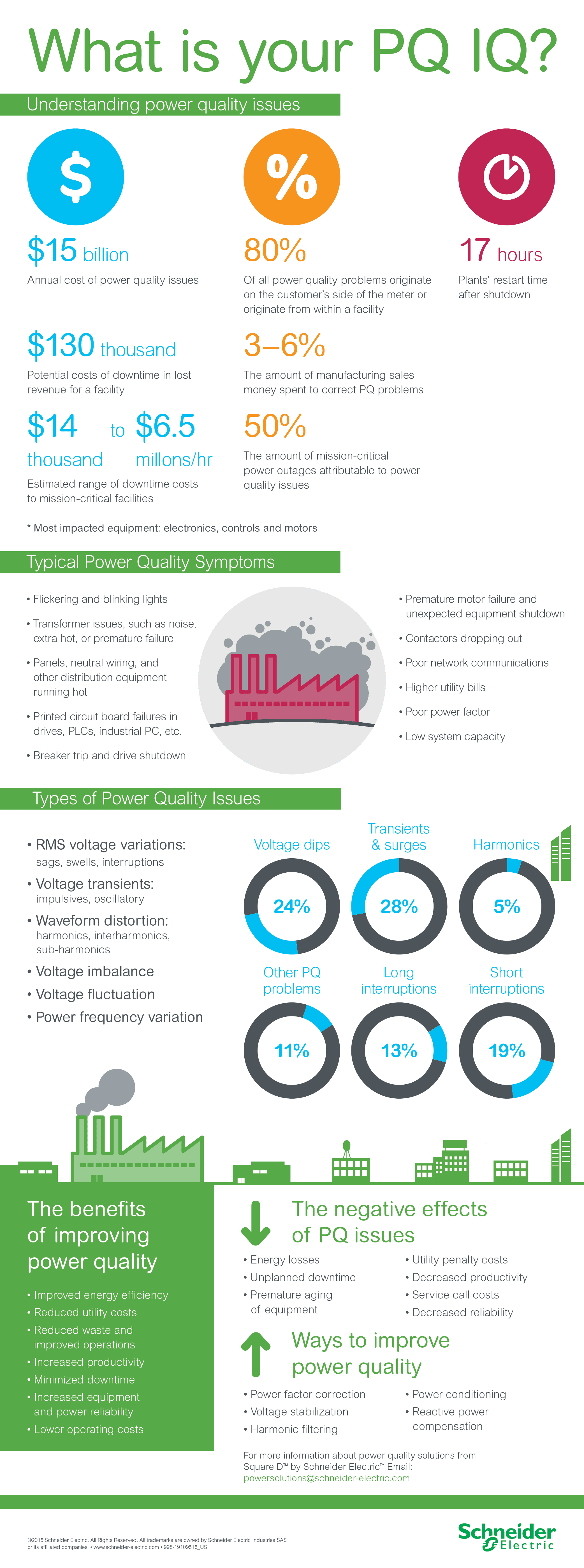What is dirty power?
Dirty power is a term that describes a variety of electrical power problems that can affect the performance and lifespan of electrical devices. It happens when the quality of the power supply is disrupted by fluctuations, voltage spikes, sags, harmonics, or electrical noise. These issues can come from inside the building, like faulty wiring or old equipment, or from outside, such as disturbances in the utility grid or nearby heavy machinery. Dirty power can cause devices to malfunction, lose efficiency, overheat, or even suffer permanent damage. Common symptoms of dirty power include:
- Flickering and blinking lights
- Transformer issues, such as noise, excessive heat, or premature failure
- Equipment vibrations and noise
- Panels, neutral wiring and other distribution equipment running hot
- Printed circuit board failures in drives, PLCs, industrial PCs and the like
- Nuisance breaker tripping
- Premature motor failure and unexpected equipment shutdown
- Contactors dropping out
- Poor network communications
- Poor power factor – resulting in utility penalties
- Lower than expected system capacity
- High CO2 emissions, poor energy efficiency
What causes dirty power?
Dirty power occurs when the electricity supplied to your home or workplace is inconsistent or contains unwanted disturbances. These disturbances can cause voltage and frequency fluctuations, spikes, or drops, which is commonly referred to as dirty power electricity. A major cause is the widespread use of electronic devices, which generate electrical noise that can feed back into power lines.
Aging or poorly maintained electrical infrastructure is another contributor. Old wiring, corroded connections, or overloaded circuits can disrupt the smooth flow of electricity, leading to interruptions and reduced efficiency. Power generation and transmission systems can also introduce dirty power. For example, sudden load changes or faults in transformers and generators can create voltage spikes or harmonic distortions.
Renewable energy sources such as solar panels or wind turbines can also cause fluctuations in the grid if they are not properly regulated. Additionally, external factors like lightning strikes or utility switching operations can produce short bursts of dirty power electricity. Understanding these causes is important because dirty power can damage sensitive electronics, shorten their lifespan, and even result in data loss or equipment malfunctions.
Infographic: Understanding dirty power

The cost of power quality issues
While dirty power is caused by a range of power quality issues, they all have one thing in common: they can be disruptive, and sometimes expensive, to your everyday operations.
How costly? About $15 billion annually, which easily tells the story. Much of that comes from downtime, the cost of which can vary from $14000 to more than $6 million per hour, depending on the type of facility in question.
Fully half of all mission-critical power outages are attributable to power quality issues. And 80% of those issues originate on the customer’s side of the electric meter, meaning in customer facilities – not with the utility.
What types of issues can be caused by dirty power?
The sorts of issues which may result in downtime or disruptions include:
- Variations in RMS voltage that causes power sags, swells and interruptions
- Voltage transients and surges
- Harmonics or waveform distortions
- Imbalance or fluctuations in voltage
- Power frequency variations
Left unchecked, such dirty power issues can cause all of the symptoms mentioned above. Some, like flickering lights, may just be annoying while others, such as equipment and wiring running hot, breakers tripping and lower system capacity – can create real, costly problems.
Hospitals, for example, have lots of sensitive equipment that don’t tolerate poor quality power very well. This also applies to industrial production lines, where a machine stoppage likely results in a financial hit and hours of unplanned downtime. Or consider amusement parks and ski lifts – applications where downtime will at best cause customer service issues and at worst create potentially dangerous situations.
How can power quality issues be fixed?
The good news is the majority of dirty power issues – 80% – occur on the customer side of the electric meter. That means customers can take steps to correct the issues. In doing so, they’ll not only avoid costly disruptions, but will also improve energy efficiency and reduce costs facility-wide.
Various power quality solutions are available to correct whatever dirty power problem may exist, including power factor correction, voltage stabilization, harmonic filtering, power conditioning and reactive power compensation. Visit our power quality management page to learn more about offerings from Schneider Electric – and clean up those dirty power issues before they cause real problems.
*This post was originally published on October 29, 2015 and has been updated for comprehensiveness.



Conversation
Thank you